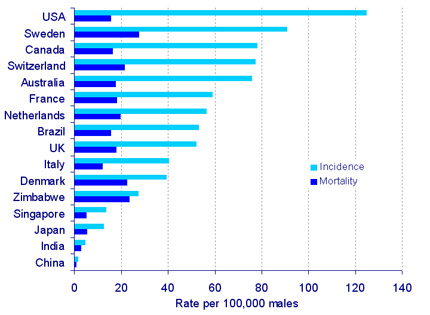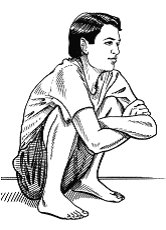|
Prostate Problems: Why it is Rare Among Chinese, Indian and Japanese Men?
Prostate problems and disorders are more prevalent in Western countries than in other parts of the world.
[The prostate - what is it?]
International Agency for Research on Cancer: "The highest prostate cancer incidence rates are in the developed world and the lowest rates in Africa and Asia."
National Cancer Institute, US National Institutes of Health: "Prostate cancer...is the most commonly diagnosed cancer among men in the United States...the incidence rates for clinical prostate cancer in Western men are 30 to 50 times higher than those for Asian men..." USA Today: "African Americans have the highest prostate cancer risk in the world .... And despite high rates among African Americans, prostate cancer is very low in Africa."
eMedicine.com: "A 200-fold difference in incidence exists between African American men, who represent the group with the highest incidence of the disease, and Chinese men living in Asia, in whom the incidence of prostate cancer is among the lowest in the world."
Displayed on a chart (below), the 200-fold difference is startling...
Looking at this chart, one can't help but ask: 1) What could be the reason for the very different rates of prostate cancer in the world? 2) Why are men in the Western countries so susceptible to prostate problems? 3) What is the 'secret factor' that had protected Chinese, Indian and Japanese men from prostate problems and cancer?
For decades, many Western researchers have been trying to find the answers. They have not find much success, as reflected in the words they use to describe prostate cancer, eg:
A common explanation given for the low incidence of prostate cancer in non-Westernised countries is a diet low in fat and high in fiber. However, the problem with this theory is that any association between diet and prostate problems and cancer has not been proven. A recent major study by researchers at Memorial Sloan-Kettering Cancer Center, the National Cancer Institute and seven other centers had dismissed this theory. The researchers reported their findings in the American Society of Clinical Oncology (August 30, 2002):
The low fat, high fiber diet theory also doesn’t make sense based on migration studies. One such study found that within one generation, the incidence of prostate cancer among Japanese immigrants increased 4 to 9 fold, even though their diet remain largely unchanged.
[Something else did changed for these Japanese immigrants. In Japan, they use squat toilets like the ones pictured here.]

As a result of growing up in a society where sitting toilets are a part of life, it is very difficult for a Western researcher to recognise and accept that the sitting toilet is the root cause of prostate problems. Yet, this is the case. It all has to do with the pudendal nerve which control prostate and bladder functions, and the descent of the pelvic floor (more on this later). The pudendal nerve emerges from the base of the spinal cord, runs through the perineum (in men, the area between the anus and penis), and passes through the pelvic floor before connecting to the prostate and bladder.
In the sitting position, the colon is not properly prepared for waste evacuation. It is in the continence mode. On a conventional (sitting) toilet, a person is forced to strain, while holding the breath, and pushing downwards with the diaphragm, in order to evacuate. This action is called the
Valsalva Maneuver.
In the sitting position, the pelvic floor is also unsupported by the thighs. As a result, each time one strains on the sitting toilet, it is repeatedly forced downwards. The pelvic floor is simply not designed to cope with this sort of stress and abuse. Each time it is depressed, the pudendal nerve which runs through the pelvic floor is stretched at the same time. Nerves are not elastic, and studies have shown that a 12% stretch destroys a nerve. This goes for the pudendal nerve, which cannot be stretched very far without being damaged. It doesn't happen right away. But slowly but surely, as the pelvic floor sags lower and lower, there comes a day when the tipping point will occur. The pudendal nerve is stretched beyond its capacity, and can no longer transmit brain signals to and from the prostate and other pelvic organs properly.
As mentioned, another reason is cultural insularity. Sitting toilets are "normal and natural" and therefore "above suspicion."
This breakdown in nervous control is the root cause of prostate problems and other pelvic-related ailments
(eg: urinary incontinence).
Every gland in the body requires constant feedback from the brain to maintain normal functioning. As the pudendal nerve deteriorates, the prostate gland becomes increasingly isolated from the central nervous system, and could become dysfunctional in one or many forms. The three most common prostate problems we see today are:
1) Benign prostatic hyperplasia (BPH)
What Can Be Done? Getting everyone to squat for waste elimination. The truth is that human beings are designed to eliminate waste in the squatting position. It is only in this posture that you can completely empty your
colon
without excessive straining or imposing any stress on the pelvic floor. Instead of pushing downwards with the diaphragm, squatting pushes upwards with the thighs. This increases the intra-abdominal pressure, which naturally compresses the colon and make it easier for waste to be emptied. Squatting also relaxes the
final pathway between the rectum and anus.
By forcing users to sit, the sitting toilet does not fulfill the natural requirements of waste elimination. It is responsible for the growing epidemic of colon, bladder, pelvic and prostate problems in Westernised countries. Worldwide, more than 650,000 men are diagnosed with prostate cancer every year. Almost 30 million men suffer from enlargement of their prostate gland (benign prostatic hypertrophy, BPH). Each year, the United States alone, over 400,000 men undergo prostate surgery each year. Over a billion dollars is spent on treating prostate problems. It is no secret why Chinese, Indian and Japanese do not have so much prostate problems as compared with Western men. They use squatting toilets instead of sitting toilets.
One will give protection against prostate problems; the other can increase your risk of prostate problems by 200 fold. But act quickly. The longer you continue to use the sitting position for waste elimination, you might lose your ability to squat, as explained on this page about squatting facets. Your ability to squat is important because if you can't, you won't be able to change your toileting posture from sitting to squatting, using one of the options described on this
page.

Nature Knows Best is the first and only book that explains the benefits of the natural squatting position and health risks of using sitting toilets.
You can find out more about Nature Knows Best by visiting this page.
Also consider taking some nutritional supplements that are known to be good for prostate health. I recommend that you buy them from
iHerb.
Have A Great Story About This Topic?Do you have a personal account about the topic discussed on this page? Please consider sharing it. You can be sure that many people in the world would love to read about and greatly benefit from your experience. It's easy to do. Just let your words flow. Thanks for sharing! What Other Visitors Have SaidClick below to see contributions from other visitors to this page...
Prostate problems and Tumeric/Capsacin
A simple guy with prostate issue, 27 years old only; Yeah, I know. Not rated yet
|
The Best Toilet Converter in The World Today!


Helping People All Over
The World Achieve
Good Health Through
Correct Toileting Posture
Watch video on the
origin and story of
the Sandun-Evaco
toilet converter
All about Life,
Hope and Truth...
FREE:
One of the most
astounding books
you will ever read
in your life!














